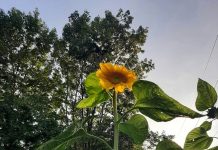By Ben Kibbey
For The Republic
In Indiana, environmental conservation is the job of the Department of Natural Resources. But it’s a job the agency doesn’t do alone.
The state also has the support of private organizations such as The Nature Conservancy, about 25 land trusts associated with the Indiana Land Protection Alliance, Friends of State Parks and the Indiana Natural Resources Foundation.
They protect land through ownership or agreements with landowners, assist with acquiring land for state parks and forests, conduct environmental education programs, and raise money and undertake projects to improve state-owned properties.
Mary McConnell, state director of The Nature Conservancy, thinks Indiana is unique in how private organizations and public entities work together, recognizing common goals instead of focusing on differences.
Cooperation can help to raise public awareness and educate people about their natural resources, said Brad Feaster, with the DNR Division of Fish and Wildlife.
Yet, McConnell feels the public is still not fully aware of how precious a commodity the state’s natural resources are, how threatened they are and how little of them are protected, she said.
The availability of natural areas and wildlife directly relate to quality of life.
“We need to raise the bar,” she said. “The way we’re going to attract and retain businesses, and how we’re going to attract and retain educated people in Indiana, is to have those natural amenities, and we don’t have many of them.”
Feaster was one of more than a dozen state and private conservation officials who came together for the Indiana Conservation Alliance’s annual Conservation Congress at Brown County State Park in the fall. He was spreading the word about Indiana’s State Wildlife Action Plan, a comprehensive effort to focus conservation agencies and organizations on common goals.
He hopes to develop even greater cooperation between the DNR and other organizations.
Feaster would like to see a “one-stop” web portal with information about all conservation efforts, and an interactive map that would show state, federal and privately owned natural areas that are open to the public and types of activities permitted there.
Currently, the DNR’s website has a map of state properties, and the Nature Conservancy has a map on its website of privately owned nature preserves that are open to the public. No map exists that combines both, and even the Nature Conservancy’s map has limited details about properties and is missing some preserves such as Stone Head Nature Preserve near Story.
A matter of trusts
About 3.5 percent of all land in Indiana is protected from development among state, federal and private groups.Altogether, 25 land trusts around the state protect about 145,000 acres, said Cliff Chapman, president of the Indiana Land Protection Alliance and executive director of the Central Indiana Land Trust.
The state and federal governments own or manage more than 724,000 acres in Indiana among state forest, national forest, state parks and fish and wildlife areas and U.S. Army Corps of Engineer reservoir properties.
“I think Indiana is a great example of how government agencies and private organizations — private not-for-profits — can work in a very collaborative way,” Chapman said. “We don’t see each other as competition; we see each other as partners.”
Money for conservation work comes from a variety of sources.
Private and public conservation groups already cooperate to help form the State Wildlife Action Plan, which allows grant money to flow from the U.S. Fish and Wildlife Service for projects in research, restoration, management and monitoring.
The President Benjamin Harrison Conservation Trust — originally the Indiana Heritage Trust — provides matching grants for conservation projects around the state to private and public agencies. It is funded by the sale of environmental license plates, Chapman said.
As the name implies, much of Sycamore Land Trust’s job is preserving land. Between land they own or have conservation easements for, the agency protects about 9,000 acres in southern Indiana.
About 1,326 of those acres are in Brown County, said SLT Communications Director Abby Perfetti. The majority are open to the public, including 852 acres in Trevlac Bluffs Nature Preserve and the Laura Hare Nature Preserve at Downey Hill.
Some of the land SLT acquires is through purchases, but whenever possible, the organization tries to get land donated, Perfetti said.
The land trust also works closely with the state, because there are times when the land trust can act quicker than the state can to buy land, Perfetti said. Then, the SLT can transfer the land to the DNR at cost when state money is available.
The SLT looks at what is nearby when considering a purchase, Perfetti said. Yet, money is the ultimate deciding factor, she said.
Some preserves connect state lands, which makes for better wildlife habitat, Perfetti said. In Brown County, Scarlet Oak Woods preserve and Laura Hare Nature Preserve at Downey Hill join with Yellowwood State Forest, Brown County State Park and Hoosier National Forest to create a single, uninterrupted block of hardwood forest.
In 2013, the Nature Conservancy bought the shuttered Camp Belmont Girl Scout camp, and it’s now headquarters for the conservancy and its 5,000-acre Brown County Hills Project. The conservancy sold around 40 acres of the camp to the state to become part of Yellowwood State Forest but retains control of around another 240 acres.
But conservation groups don’t have to own land to help preserve it, Perfetti said. Another option is conservation easements.
Conservation easements give the SLT legal standing to ensure future owners do not develop the land beyond the wishes of the current owner, while the owner retains all other property rights.
In southern Indiana, people commonly look at a conservation easement to protect something such as a family farm, she said.
Supporting casts
Environmental education work is also integral to what conservation organizations such as the SLT does, Perfetti said.The SLT leads interpretive hikes open to the public and hands-on programs coordinated with local schools.
Sycamore Land Trust Environment Education Director Shane Gibson is currently involved with projects at Helmsburg Elementary School. Gibson goes into classrooms and does long-term projects with the students that can help them get through any fears about bugs and the outdoors, Perfetti said.
But much of the work actually depends on volunteers, as the actual staff of the nonprofit is only six people, Perfetti said.
The Friends of State Parks are groups of volunteers who support individual parks.
At Brown County State Park, Friends volunteer for events and work projects and raise money for those projects, said Kevin Snyder, assistant property manager at the park.
The paved Friends Easy Access Trail near the park’s main office was completely constructed by that group. Friends also built a fishing dock on Ogle Lake, restored the log gatehouse at the west park entrance and bought lifesaving defibrillators and other equipment for park staff.
Friends have also assisted other groups doing activities at the park, such as Heroes on the Water when they offered veterans a chance to go kayaking on Ogle, Snyder said.
“They’re able to do a lot of things for us that we can’t do for ourselves as the state,” said Doug Baird, property manager. “They’re not necessarily constrained by state purchasing rules and all the red tape that goes along with that.”
Vicky Wyatt is vice president of Friends of Brown County State Park. Her grandfather was the superintendent of the park when she was growing up.
Kayla Snyder has that personal connection, too; she first started going to Friends meetings in seventh grade, because her dad, Kevin, told her she had to, she said. But as she got more involved, she found herself looking for ways to get her peers involved too, like the Haunted Trail.
“I’ve grown up in parks my whole life, and it really gives me an inside look as to how important little actions can be,” she said.




